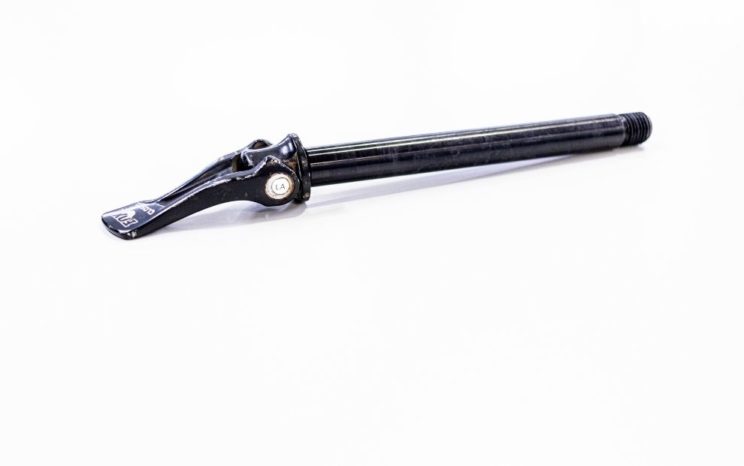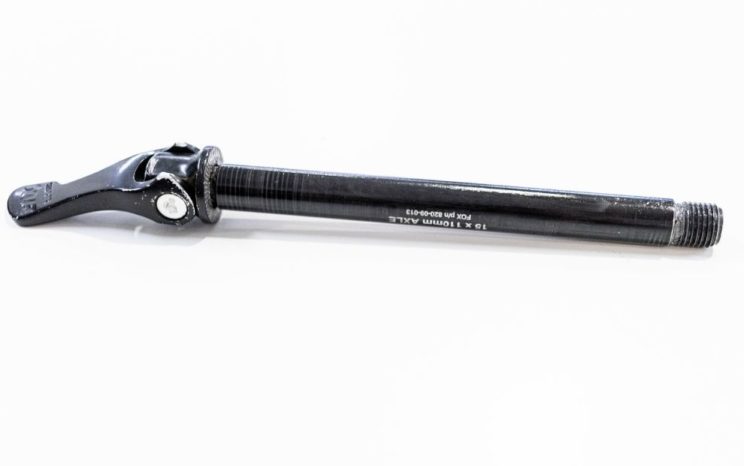The axes, bushings and closures of the wheels are components of the bicycle that are not paid as much attention as to others. But they become very important in terms of behavior and sensations of the bicycle. And also of its maintenance.
The three pieces together are responsible for guaranteeing the fixation and integration of the wheel with the bike box, as well as the stability and rigidity of the moving wheel. In this general guide we make known its most used features, measures and standards in the market based on the modality or preferential use of the model in which they are mounted.
Also, we also give you some maintenance tips to avoid slack and breakdowns.
Wheel axes: function, types and maintenance
The axis of the wheel of your bicycle is the fundamental piece of union between the first and the second and supports much of the force and loads that are exerted on the wheel. That is why it must be rigid and resistant.
The axis is a component that has evolved little in last decades but that in the last ten years has seen many measures and sizes that make it impossible to speak today of a unique standard. However, three main types of bicycle wheel axis can be differentiated, which can be found in all modalities (mountain cycling, severe road cycling and cycling).
Traditional QR axis

It was the most used type of axis before the arrival of the interns and Boost. Both the fork and the rear toe of the box have open slots below where to host this 9 mm diameter axis, with springs and closing plugs at their ends, to guarantee a correct fixation, closure and easy extraction.
The front axle is 100 mm wide and the 135 mm rear. Both have a QR fast opening lever that allowed to extract or install the wheel on the bike with some speed. In recent years he has lost presence in wheel and bicycles assemblies, seeing only in low ranges and on ride or hybrid bicycles.
15 and 12 mm intern axis

They are the first interns that appeared in the early last decade, coinciding with the popularization of disc brakes. They increase the diameter at 15 mm and 12 mm for the front and rear wheel, respectively, and maintain the same width of 100 mm and 135 mm in their first generations, to subsequently increase to 142 mm in the rear.
On the other hand they change their form and mode of extraction. Instead of being threaded on both sides and coming with docks, it is a solid screw that passes on one side, crosses the bushing and threads on the other side. This facilitates the extraction of the wheel and provides more rigidity and stability to the wheel assembly and, consequently, to the entire bicycle.
Boost axes

They became popular on mountain bicycles a few years ago as a way of giving one more stiffness to both axes and modifying the chain line to design larger wheel steps to house wider covers without sacrificing the weight.
Thus, the front axle adopted the 15x110 mm standard and the 12x148 mm rear. It is the type of axis that has been imposed in most mountain bicycles today and many road bicycles and grave.
In addition to these three types of reference axis, in radical modalities of mountain cycling such as the enduro or the descent, axes of greater width are usually monisable to give greater stability and poise to the bicycle to when facing technical declines. They are interns and with 120 mm widths in front and 150 mm or 157 mm behind.
Axes maintenance
Once a minimum, the axis and wheel should be disassembled and the me fork slots or threads well (depending on whether traditional or interior axis is used) and all parts of the axis and apply a bit of assembly fat in their ends, or all over the surface if they are interns. This will facilitate rapid extraction or assembly of the wheel on the bike and avoid the appearance of squeaks or slacks.
The bushing: materials, types and maintenance
The bushing is a fundamental piece of the wheel. Wrap the axis, join the endings of the radios, house the brake disc and serve as a support for the cassette in the case of the rear, responsible for transmitting the movement of the transmission to the wheel to turn. In addition, it grants stiffness and stability to both wheels and is decisive for bicycle control when you upload or turn.
The star material of bicycles is aluminum. Although its internal parts, nuts, trinquetes, etc. They are usually made of steel, as well as the bearings that include inside. There are also carbon or titanium fiber, although they are much more exclusive and reserved for wheels or high -end bike assemblies.
It is convenient to do an interior cleaning and greased from the bushings at least once a year
As for measures, they have the same axis wide -said. In the case of the rear bushing, they house an extension to install the cassette, the so -called cassette nucleus. Boost bushings will end up being wider and thick than those of standard or QR axis of 9 mm, thus contributing more rigidity and poise to the wheel but also more weight.
With regard to maintenance, each of them should be dismantled, both front and rear, and perform a thorough cleaning (including bearings) at least once a year. In the following BTT Globeros video they explain, step by step, how to do maintenance correctly. A preventive operation that will avoid slack and avoid more expensive breakdowns.
https://youtu.be/5aa-qWTNZxY
Wheel closures: Which one suits me for my bicycle?
Finally, you have to talk about the different types of wheel closures, which serve to mount and disassemble the wheel and guarantee a correct fixation of it to the box or bicycle fork.
The most used type of closure for decades is the Quick Release or rapid closure and is the most recommended if you do Mountain Bike sporadically and you are not very skilled riding and dismantling wheels. A small lever that serves to tighten or unlear the axis fixing screw to the bike, depending on whether or not we want to disassemble the wheel.
But in recent years, and with the aim of preventing the lever from being broken due to excessive tightening force, or objects or impacts of objects, nut closures have been popularized that open by means of a determined Allen key, such as The SRAM Maxle Stealth. It is also the system used in the new Cannondale with Lefty or Monobrazo fork.
In this way, you will prevent the rapid closing lever from being damaged or broken by blocking the extraction of the wheel, with the extra benefit of reducing some grams (30 for each axis) of your bicycle. On the other hand, you must carry with you at all times a Allen type key appropriate to the size of the nut. It is a more specific type of axis and limited to medium and high range bicycles.
 It was the most used type of axis before the arrival of the interns and Boost. Both the fork and the rear toe of the box have open slots below where to host this 9 mm diameter axis, with springs and closing plugs at their ends, to guarantee a correct fixation, closure and easy extraction.
The front axle is 100 mm wide and the 135 mm rear. Both have a QR fast opening lever that allowed to extract or install the wheel on the bike with some speed. In recent years he has lost presence in wheel and bicycles assemblies, seeing only in low ranges and on ride or hybrid bicycles.
It was the most used type of axis before the arrival of the interns and Boost. Both the fork and the rear toe of the box have open slots below where to host this 9 mm diameter axis, with springs and closing plugs at their ends, to guarantee a correct fixation, closure and easy extraction.
The front axle is 100 mm wide and the 135 mm rear. Both have a QR fast opening lever that allowed to extract or install the wheel on the bike with some speed. In recent years he has lost presence in wheel and bicycles assemblies, seeing only in low ranges and on ride or hybrid bicycles.
 They are the first interns that appeared in the early last decade, coinciding with the popularization of disc brakes. They increase the diameter at 15 mm and 12 mm for the front and rear wheel, respectively, and maintain the same width of 100 mm and 135 mm in their first generations, to subsequently increase to 142 mm in the rear.
On the other hand they change their form and mode of extraction. Instead of being threaded on both sides and coming with docks, it is a solid screw that passes on one side, crosses the bushing and threads on the other side. This facilitates the extraction of the wheel and provides more rigidity and stability to the wheel assembly and, consequently, to the entire bicycle.
They are the first interns that appeared in the early last decade, coinciding with the popularization of disc brakes. They increase the diameter at 15 mm and 12 mm for the front and rear wheel, respectively, and maintain the same width of 100 mm and 135 mm in their first generations, to subsequently increase to 142 mm in the rear.
On the other hand they change their form and mode of extraction. Instead of being threaded on both sides and coming with docks, it is a solid screw that passes on one side, crosses the bushing and threads on the other side. This facilitates the extraction of the wheel and provides more rigidity and stability to the wheel assembly and, consequently, to the entire bicycle.
 They became popular on mountain bicycles a few years ago as a way of giving one more stiffness to both axes and modifying the chain line to design larger wheel steps to house wider covers without sacrificing the weight.
Thus, the front axle adopted the 15x110 mm standard and the 12x148 mm rear. It is the type of axis that has been imposed in most mountain bicycles today and many road bicycles and grave.
In addition to these three types of reference axis, in radical modalities of mountain cycling such as the enduro or the descent, axes of greater width are usually monisable to give greater stability and poise to the bicycle to when facing technical declines. They are interns and with 120 mm widths in front and 150 mm or 157 mm behind.
They became popular on mountain bicycles a few years ago as a way of giving one more stiffness to both axes and modifying the chain line to design larger wheel steps to house wider covers without sacrificing the weight.
Thus, the front axle adopted the 15x110 mm standard and the 12x148 mm rear. It is the type of axis that has been imposed in most mountain bicycles today and many road bicycles and grave.
In addition to these three types of reference axis, in radical modalities of mountain cycling such as the enduro or the descent, axes of greater width are usually monisable to give greater stability and poise to the bicycle to when facing technical declines. They are interns and with 120 mm widths in front and 150 mm or 157 mm behind.












